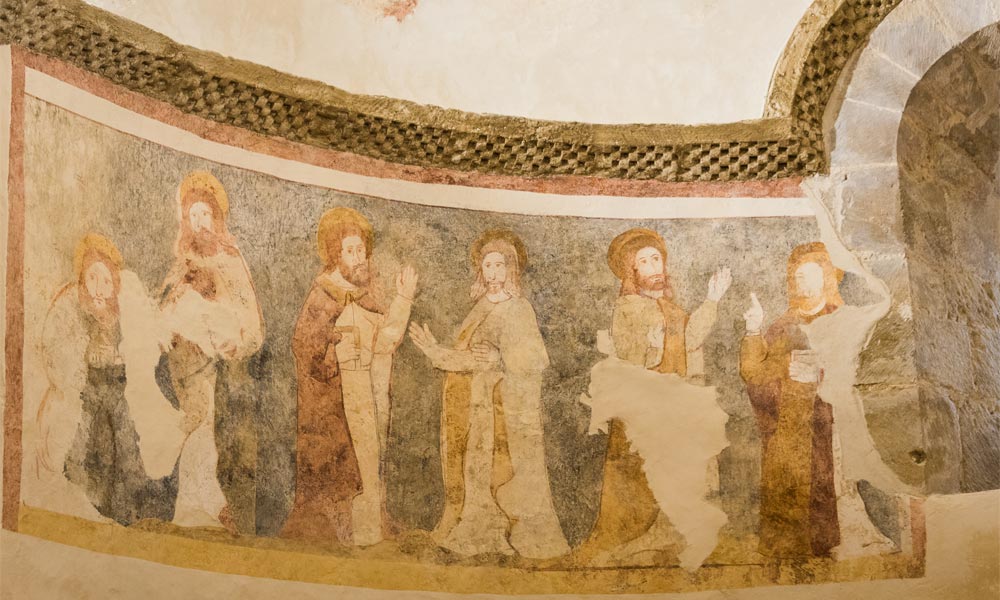Chapelle de Sainte-Foi
Le Domaine de la Trille offre une vue charmante sur le village de Sainte Foi et sa chapelle. A 5 min à pied de la ferme, découvrez ce patrimoine entièrement restauré aux belles fresques murales.
La Chapelle est classée Monument Historique depuis 1995.
Sainte-Foi possède au sommet de la colline une charmante chapelle du XIIe siècle dans laquelle subsistaient quelques fresques. Le cadre est magnifique avec de très beaux arbres sous lesquels se blottit un petit cimetière.
La chapelle de Sainte-Foi est mentionnée en 1207 dans un inventaire des biens gérés par l'Abaye de Sainte Foy de Conques dans l'Aveyron.
Admirablement bien placé sur la route allant d'Aragon vers Conques elle fut érigée sur un promontoire, probablement ancien sanctuaire mérovingien afin de racheter le site païen comme ce fut souvent le cas à l'époque. Elle est de forme cruciforme dirigée d'est en ouest, elle est typique du style des chapelles romanes languedociennes.
Elle est bâtie en gros moellons de pierre, le toit est en tuile canal mais sans doute à l'origine en dalles de pierre avec un clocher à double arcade et un porche abritant l'entrée.
A l'intérieur on trouve, un sol en dalles de terre cuite, un bénitier et les fonts baptismaux monolithes, le chœur est souligné par une intéressante frise à billettes et comporte des traces de fresques du XIVe siècle composées de personnages bibliques.
Il se dégage de ce lieu une atmosphère de sérénité et de recueillement dans un magnifique paysage où l'on aperçoit la chaîne des Pyrénées.
Sainte-Foi d’Ariège et Sainte-Foy de Conques
« L’abbaye de Sainte-Foy de Conques en Aveyron fut fameuse et prospère durant tout le Moyen Âge après avoir récupéré les reliques de la Sainte elle se développa considérablement.
Elle envoya même des missionnaires qui dans le sud de la France donnèrent le nom de Sainte-Foy a une bonne vingtaine de villages, Sainte-Foy d’Ariège en fait partie et à ce titre nous pouvons dire que nous sommes une fondation conquoise. »
Sainte Foi
L'histoire retient que Foy, fille d'un notable romain d'Agen se convertit au catholicisme sous l'influence de sa nourrice, à l'âge de 12 ans. En 302 après J.C, Dacien, proconsul d'Aquitaine, applique avec vigueur l'édit anti-chrétien de l'empereur Dioclétien. Foy tombe dans les griffes du proconsul. Il y a de la Jeanne d'Arc dans Sainte-Foy car malgré toutes les tortures, elle n'abjure pas. Le proconsul la condamne alors au supplice du grill. Un orage providentiel éteint le feu. Fou de rage Dacien la fait alors décapiter. Sa dépouille enterrée et vite vénérée aurait été à l'origine de bien des miracles autour du tombeau de la sainte, ce qui fit sa notoriété. On lui attribue notamment le fait d'avoir délivré des prisonniers.
Sur le coin inférieur gauche du tympan de l'abbatiale de Conques, Foy est représentée prosternée. Derrière elle, pendent les fers des prisonniers libérés par son intercession.
Sainte-Foy, "star" du premier tube occitan !
Pas de CD, pas de FM en l'an 1000. Et pourtant, la chanson de Sainte-Foy va devenir un vrai tube. Elle va se fredonner durant des siècles contribuant à asseoir davantage la réputation de Conques. L'histoire de Sainte Foy est l'un des premiers poèmes occitans. Mis en parole, il se chantera sur le chemin de Saint-Jacques et donnera du cœur au ventre pour bouter l'infidèle hors d'Espagne ! Car dans le même temps, Sainte-Foy va devenir non seulement l'une des saintes les plus vénérées du Moyen-Age mais également l'un des symboles de la Reconquista, la reconquête de l'Espagne.








